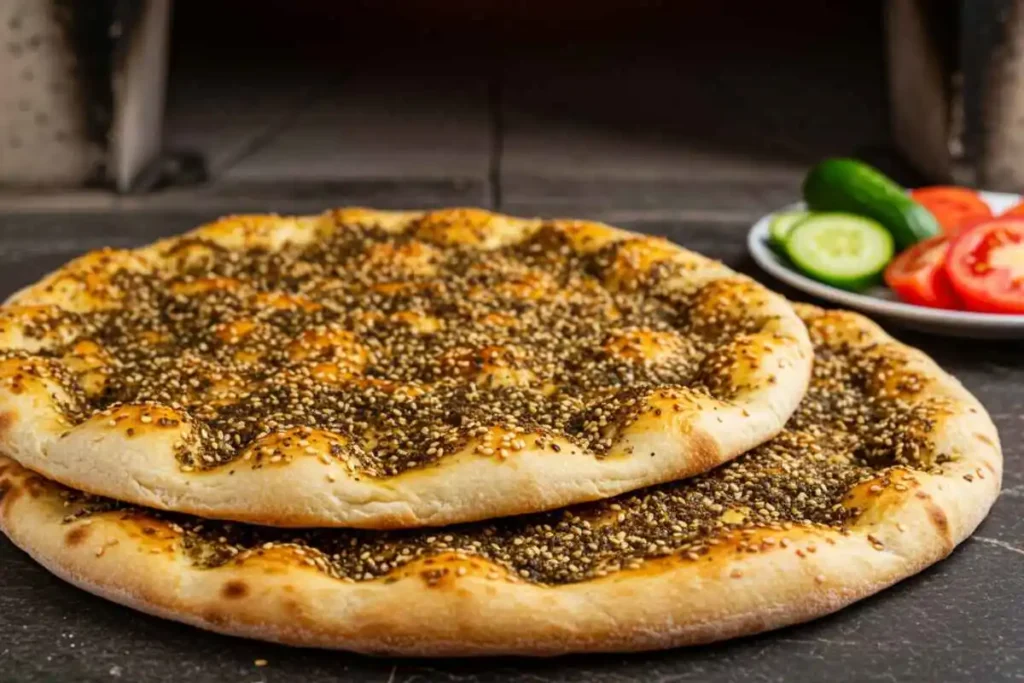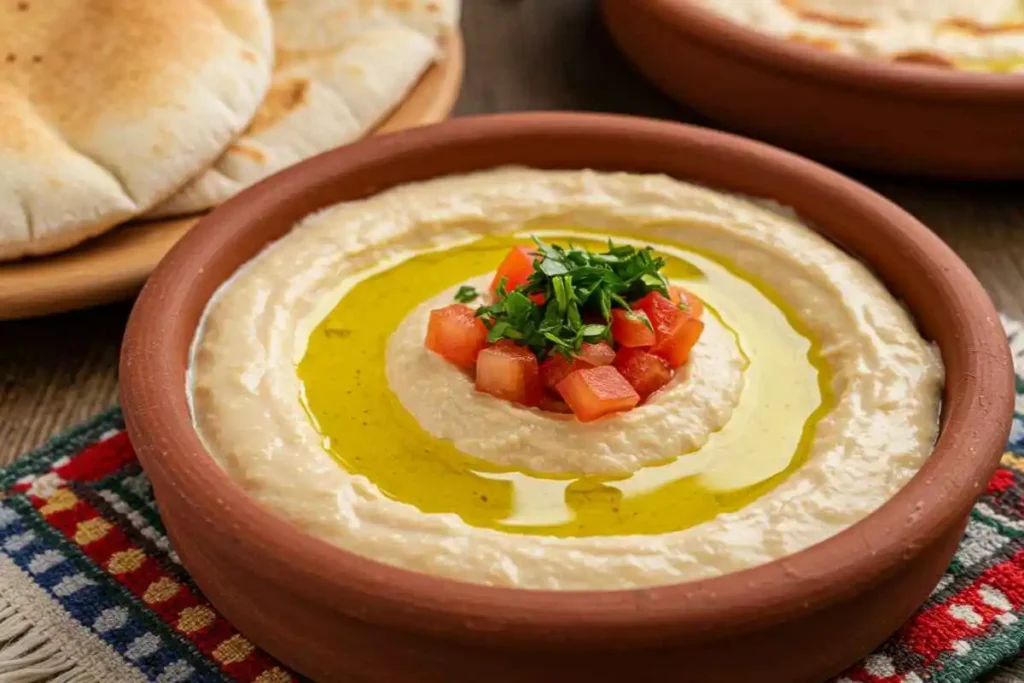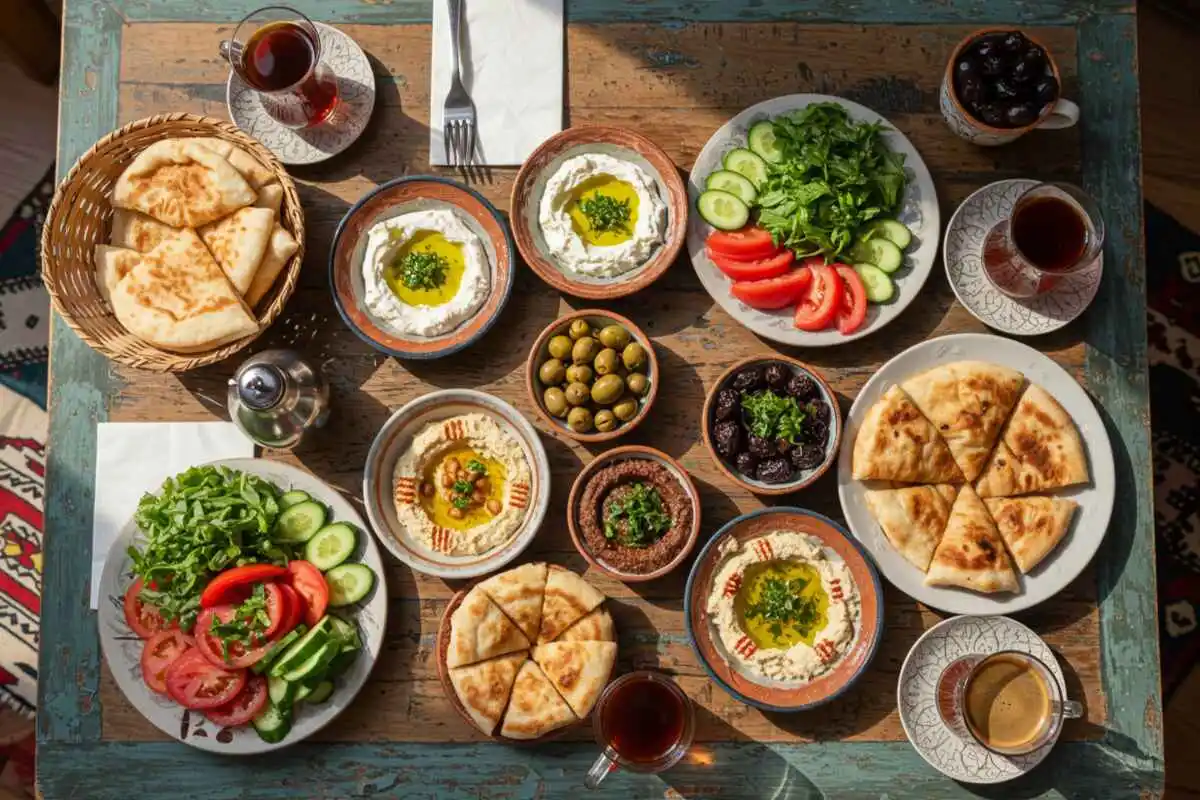1. Introduction
A typical Lebanese breakfast is a delightful blend of fresh, flavorful, and nutritious ingredients, deeply rooted in Lebanon’s rich culinary traditions. Unlike Western breakfasts, which often rely on processed foods, a Lebanese breakfast emphasizes natural, wholesome foods such as freshly baked manakish, creamy labneh, hearty ful medames, and a variety of olives, cheeses, and fresh vegetables. These elements come together to create a balanced and satisfying morning meal.
Breakfast in Lebanon is more than just food—it is a social and cultural experience. Families and friends gather around the table, sharing dishes mezze-style, accompanied by a warm cup of Arabic coffee or mint tea. Whether enjoyed at home, in a local bakery, or at a bustling street café, a typical Lebanese breakfast is a celebration of tradition, flavor, and hospitality.
In this article, we will explore the essential components, regional variations, and popular dishes of a traditional Lebanese breakfast, as well as modern adaptations and how to prepare an authentic meal at home.
2. Historical Context of Lebanese Breakfast
The history of Lebanese breakfast is deeply intertwined with the country’s agricultural and cultural heritage. Lebanon’s Mediterranean climate provides the perfect conditions for growing wheat, olives, dairy products, legumes, and fresh vegetables—all of which form the backbone of a traditional Lebanese breakfast.
Ancient Influence
Lebanon’s breakfast traditions date back thousands of years, influenced by ancient civilizations, including the Phoenicians, Romans, and Ottomans. In ancient times, the Phoenicians cultivated wheat, olives, and figs, which were commonly consumed in the morning alongside fresh cheeses and honey.
During the Ottoman Empire (1516–1918), new flavors and techniques were introduced, such as the use of spices like sumac, cumin, and cinnamon. The Ottomans also introduced new baking techniques, leading to the rise of manakish, ka’ak, and other flatbreads that remain breakfast staples today.
Rural Traditions
In rural areas, breakfast was often a simple but nutritious meal, consisting of:
- Freshly baked flatbreads made from wheat flour.
- Labneh (strained yogurt) drizzled with olive oil.
- Legume-based dishes like ful medames (fava beans) and balila (chickpeas).
- Local dairy products, such as goat cheese and yogurt.
This breakfast provided the energy needed for a long day of farming and labor. Farmers would dip bread into olive oil and za’atar, creating a quick yet highly nutritious meal that is still enjoyed today.
Breakfast as a Social Experience
Breakfast in Lebanon is not just about food—it’s about community and hospitality. Traditionally, extended families and neighbors gathered around a table to share food and conversations. Even today, Lebanese breakfasts are often shared meals, where multiple small plates (mezze-style) are served and enjoyed together.
In modern times, while urban lifestyles have influenced breakfast habits, many Lebanese still preserve these traditional elements, ensuring that breakfast remains a cherished daily ritual.
3. Core Components of a Lebanese Breakfast
A traditional Lebanese breakfast is made up of a variety of fresh and wholesome ingredients that are rich in flavor and nutrition. Unlike Western breakfasts, which often rely on processed foods, Lebanese breakfasts are rooted in natural ingredients, providing a balanced combination of proteins, healthy fats, and carbohydrates.
Below are the essential components of a Lebanese breakfast:
3.1. Breads and Pastries
Bread is an integral part of Lebanese cuisine, especially for breakfast. It serves as the base for many dishes and is used to scoop up dips, cheeses, and legumes. Some of the most common types of Lebanese bread include:
- Pita Bread (Khubz Arabi): A soft, round flatbread used for wrapping or dipping.
- Manakish: A Lebanese flatbread topped with za’atar (thyme, sumac, and sesame seeds), cheese, or minced meat.
- Ka’ak: A sesame-covered bread ring, often enjoyed with cheese or dipped in tea.
- Markouk: A thin, paper-like flatbread cooked on a saj (dome-shaped griddle), often used for wraps.
3.2. Dairy Products
Lebanese breakfast often includes a variety of dairy-based dishes that are both delicious and nutritious:
- Labneh: A thick, tangy strained yogurt cheese often drizzled with olive oil and sprinkled with za’atar.
- Akkawi Cheese: A mild, slightly salty white cheese that pairs well with olives and bread.
- Halloumi Cheese: A semi-hard cheese, often grilled or pan-fried for extra flavor.
Dairy products are typically served alongside fresh vegetables, olives, and herbs, adding a refreshing contrast to their creamy texture.
3.3. Legume-Based Dishes
Legumes are a staple of Lebanese breakfasts, providing a rich source of protein and fiber. These dishes are hearty, filling, and full of flavor:
- Ful Medames: A dish of slow-cooked fava beans, mashed with garlic, lemon juice, and olive oil.
- Balila: Warm chickpeas flavored with cumin, garlic, and lemon juice.
- Hummus: A classic Lebanese spread made from blended chickpeas, tahini, garlic, and lemon juice.
These dishes are typically enjoyed with pita bread and fresh vegetables, making them a satisfying and balanced meal.
3.4. Egg Preparations
Eggs are a common breakfast ingredient, prepared in various ways:
- Bayd Matboukh: Scrambled eggs cooked with onions and tomatoes, sometimes with sumac for extra flavor.
- Eggs with Sujuk: Spicy Lebanese sausages served with fried or scrambled eggs.
- Eggs with Awarma: A dish of scrambled eggs cooked with Awarma (preserved lamb confit), giving it a rich and meaty flavor.
Eggs are often eaten with pita bread and a side of fresh herbs, making them a nutritious and delicious start to the day.
3.5. Pickles and Olives
Pickled vegetables and olives are an essential side dish in Lebanese breakfasts. They add tangy and salty flavors that complement the other dishes.
Common picks include:
- Makdous: Pickled baby eggplants stuffed with walnuts and garlic.
- Lebanese Green Olives: Often marinated with lemon and chili.
- Turnip Pickles: Bright pink pickled turnips, a popular Lebanese side dish.
3.6. Fresh Vegetables and Herbs
Lebanese breakfasts are fresh and wholesome, often including tomatoes, cucumbers, radishes, and mint leaves. These refreshing vegetables and herbs add a crisp, vibrant touch to the meal.
4. Popular Lebanese Breakfast Dishes
Lebanese breakfasts feature an array of iconic dishes that have been enjoyed for generations. Here are some of the most popular breakfast dishes in Lebanon:

4.1. Manakish – The Lebanese Pizza
Manakish is one of Lebanon’s most beloved breakfast dishes. This delicious flatbread is topped with:
- Za’atar (thyme, sumac, and sesame seeds) for an herby, tangy flavor.
- Cheese (Akkawi or Kashkaval) for a rich, creamy taste.
- Minced meat (Lahm Bi Ajeen) for a hearty option.
Manakish is baked in a stone oven and often served with fresh cucumbers, tomatoes, and olives. It’s a go-to breakfast for many Lebanese families.
4.2. Fatteh – A Hearty, Layered Dish
Fatteh is a rich, layered breakfast dish made with:
- Toasted pita chips (for crunch).
- Chickpeas (for protein).
- Garlic-yogurt sauce (for creaminess).
- Toasted pine nuts (for extra flavor).
This dish is often topped with olive oil and sumac, giving it a deliciously tangy and nutty taste.
4.3. Ful Medames – A Protein-Packed Dish
Ful Medames is a dish of slow-cooked fava beans, mashed and mixed with:

- Garlic and lemon juice for a zesty kick.
- Olive oil for smoothness.
- Cumin and sumac for extra depth of flavor.
This dish is best enjoyed with warm pita bread, fresh vegetables, and olives.
4.4. Labneh – The Ultimate Lebanese Yogurt
Labneh is a thick, creamy yogurt cheese that is:
- Spread onto pita bread.
- Drizzled with olive oil.
- Sprinkled with za’atar or dried mint.
It’s a simple yet delicious and healthy breakfast option.
4.5. Balila – Warm Chickpea Delight
Balila is a dish of warm, tender chickpeas flavored with:
- Cumin for an earthy flavor.
- Garlic for depth.
- Lemon juice and olive oil for freshness.
It’s often served with pita bread and fresh herbs.
4.6. Ka’ak – The Lebanese Street Bread
Ka’ak is a sesame-coated bread ring, commonly sold by street vendors in Lebanon. It is:
- Often filled with cheese or za’atar.
- Crispy on the outside, soft on the inside.
- Enjoyed with a cup of mint tea or Arabic coffee.
4.7. Knefeh – A Sweet Breakfast Treat
Knefeh is a cheese-filled semolina pastry, soaked in sugar syrup and often served in ka’ak bread. It’s:
- Sweet, creamy, and crunchy.
- Popular for weekend breakfasts or special occasions.
- Often paired with a glass of sweetened tea or Arabic coffee.
5. Regional Variations in Lebanese Breakfasts
Lebanon’s diverse geography and rich cultural heritage have influenced the way breakfast is enjoyed across different regions. While the core ingredients remain the same, each area has its own unique variations and specialties.
5.1. Coastal Regions (Beirut, Tripoli, Sidon)
In coastal cities, where fresh seafood is abundant, people often incorporate fish-based dishes into breakfast. Some variations include:
- Samak Harra (Spicy Fish): A dish of grilled fish with a garlic-tahini sauce.
- Seafood Fatteh: A unique take on fatteh, where fish replaces chickpeas.
- Fish Kebbeh: A coastal twist on the classic meat kebbeh, made with ground fish and bulgur.
Additionally, coastal areas are famous for their Knefeh, often enjoyed in a sesame-coated bread roll as a quick breakfast on the go.
5.2. Mountainous Regions (Bekaa Valley, Mount Lebanon)
The colder climate in the mountains calls for heartier breakfasts, focusing on dairy, meat, and legumes. Some popular dishes include:
- Awarma and Eggs: Preserved lamb confit scrambled with eggs for a rich, protein-packed meal.
- Goat Cheese and Honey: Fresh cheese served with honey and walnuts.
- Thick Labneh: In villages, labneh is often homemade and has a stronger, tangier taste.
Villagers in these regions also eat warm stews like Kishk, a fermented yogurt and bulgur porridge, perfect for chilly mornings.
5.3. Northern Lebanon (Akkar, Zgharta, Batroun)
The north is famous for its spiced meat dishes and hearty breads. Breakfast specialties include:
- Lahm Bi Ajeen: A spicy minced meat flatbread, similar to manakish but with a stronger flavor.
- Sfeeha Baalbakiyeh: Mini meat pies, seasoned with pomegranate molasses and sumac.
- Batata Harra: Spiced fried potatoes with garlic, coriander, and chili.
The northern region is also known for its rich olive oils and fresh thyme, making za’atar manakish particularly popular here.
5.4. Southern Lebanon (Tyre, Nabatieh, Marjayoun)
Southern Lebanese breakfasts are often simpler, focusing on fresh produce, herbs, and legumes. Some favorites include:
- Msabbaha: A creamier version of hummus, served warm with whole chickpeas.
- Pickled Wild Thyme: A southern specialty, often eaten with labneh and bread.
- Foul Akhdar: A fresh fava bean salad, different from ful medames.
Southern Lebanon is also home to some of the best olives in the country, often eaten with fresh za’atar and cheese.
6. The Role of Beverages in Lebanese Breakfast
No Lebanese breakfast is complete without a hot or cold beverage to accompany the meal. Drinks play an important role in enhancing flavors and promoting digestion.
6.1. Arabic Coffee (Ahweh)
Arabic coffee is a cultural staple in Lebanon. It is:
- Strong and aromatic, with a hint of cardamom.
- Served in small cups to be sipped slowly.
- Usually unsweetened, but sugar can be added upon request.
Coffee is often enjoyed before or after breakfast, setting the tone for the day.

6.2. Lebanese Mint Tea (Shai bi Na’na)
Mint tea is one of the most common breakfast beverages in Lebanon. It is:
- Made with black tea leaves, fresh mint, and sugar.
- Served in small glass cups.
- Believed to aid digestion and provide relaxation.
Many people prefer tea over coffee in the morning, as it is lighter on the stomach.
6.3. Ayran (Laban Drink)
Ayran is a refreshing yogurt-based drink that complements savory breakfast dishes. It is:
- Lightly salted and served cold.
- Great for digesting heavy meals like fatteh.
- Rich in probiotics and calcium.
It is particularly popular in the mountain regions of Lebanon.
6.4. Fresh Juices
Lebanese breakfasts are sometimes paired with freshly squeezed juices, such as:
- Orange juice: A vitamin-C boost in the morning.
- Pomegranate juice: Rich in antioxidants and slightly tart.
- Carrot juice with ginger: A common homemade juice for immunity and digestion.
Fresh juices add a refreshing contrast to the warm, rich flavors of Lebanese breakfast.
7. Nutritional Aspects of Lebanese Breakfast Foods
A traditional Lebanese breakfast is not only delicious but also highly nutritious. It provides:
7.1. High-Quality Proteins
From legumes (ful medames, hummus, balila) to dairy (labneh, cheese) and eggs, Lebanese breakfasts are rich in protein. This helps with:
- Muscle repair and growth.
- Sustained energy levels throughout the day.
- Increased satiety, reducing cravings.
7.2. Healthy Fats
Olive oil, nuts, and dairy provide essential healthy fats, which are beneficial for:
- Brain function and heart health.
- Anti-inflammatory properties.
- Better absorption of fat-soluble vitamins (A, D, E, K).
7.3. Complex Carbohydrates
Unlike refined cereals, Lebanese breakfasts include whole grains and legumes, offering:
- Slow-releasing energy, keeping blood sugar levels stable.
- High fiber content, promoting digestion.
- Better gut health due to resistant starches in chickpeas and fava beans.
7.4. Vitamins and Antioxidants
Fresh vegetables, olives, and herbs contribute a variety of vitamins and minerals, including:
- Vitamin C (from tomatoes, lemon juice, and pomegranate).
- Iron and magnesium (from legumes).
- Calcium (from dairy and sesame seeds).
This combination supports immune health, strong bones, and overall well-being.
8. Lebanese Breakfast in Modern Times
While traditional Lebanese breakfasts remain popular, modern adaptations have emerged due to busy lifestyles and global influences.
8.1. Urban vs. Rural Breakfasts
- In rural villages, people still enjoy home-cooked, traditional meals, with homemade bread, labneh, and olive oil.
- In cities like Beirut, many people opt for grab-and-go options, such as manakish, Knefeh sandwiches, and coffee-to-go.
8.2. Healthier Alternatives
With a growing focus on health-conscious eating, some Lebanese have adapted traditional dishes by:
- Using whole-grain manakish dough instead of white flour.
- Replacing fried foods with grilled or baked alternatives.
- Adding avocado and chia seeds to traditional dishes like labneh toast.
8.3. Global Influence on Lebanese Breakfast
As Lebanese people migrate worldwide, they introduce their cuisine to different cultures. Some fusion dishes include:
- Za’atar Avocado Toast – A blend of Lebanese and Western flavors.
- Hummus & Eggs on Whole-Grain Bread – A Mediterranean-inspired breakfast dish.
- Smoothie Bowls with Dates and Nuts – A mix of Lebanese and modern health trends.
These adaptations help preserve Lebanese traditions while catering to modern preferences.
9. How to Prepare a Traditional Lebanese Breakfast at Home
If you want to experience the authentic flavors of a Lebanese breakfast, you can easily recreate it at home using fresh ingredients and simple techniques. Below is a step-by-step guide to preparing a traditional Lebanese breakfast spread.
9.1. Essential Ingredients
To prepare a delicious Lebanese breakfast, you will need the following staple ingredients:
Breads and Pastries:
Pita Bread – Soft and chewy flatbread.
Manakish Dough – To make za’atar or cheese flatbreads.
Ka’ak – Sesame-covered bread rings.
Dairy and Cheeses:
Labneh – Strained yogurt cheese.
Akkawi Cheese – Mild white cheese.
Halloumi Cheese – A grilling cheese.
Legume-Based Dishes:
Chickpeas – For hummus and balila.
Fava Beans – For ful medames.
Fruits & Vegetables:
Tomatoes, Cucumbers, Mint, Radishes – For a fresh salad.
Olives – Green or black, marinated with lemon.
Spices and Condiments:
Za’atar – A mix of thyme, sumac, and sesame seeds.
Olive Oil – A key component of Lebanese cuisine.
Sumac – A tangy, lemony spice.
9.2. Step-by-Step Preparation Guide
1: Prepare the Breads
If making manakish, roll out dough, spread za’atar or cheese topping, and bake in a preheated oven at 220°C (430°F) for 10-12 minutes. If using pita bread, warm it slightly before serving.
2: Make the Dairy-Based Dishes
- Spread labneh onto a plate, drizzle with olive oil, and sprinkle with za’atar.
- Slice Akkawi cheese and serve alongside bread and olives.
3: Cook the Legume Dishes
- To make ful medames, mash cooked fava beans and mix with garlic, lemon juice, and cumin. Drizzle with olive oil and serve warm.
- For balila, warm chickpeas in a pan with garlic, olive oil, and cumin, then serve.
4: Prepare the Fresh Sides
- Slice tomatoes, cucumbers, and radishes, then arrange them on a plate.
- Add a bowl of olives and some fresh mint leaves.
5: Serve the Drinks
- Brew Lebanese mint tea or make Arabic coffee.
- If desired, serve fresh orange or pomegranate juice.
6: Assemble and Enjoy!
Arrange everything on a large platter or multiple small plates, mezze-style. Enjoy the combination of flavors, using bread to scoop up labneh, hummus, or ful medames.
10. Frequently Asked Questions (FAQs)
10.1. What does Lebanon eat for breakfast?
Lebanese people enjoy a variety of savory and slightly sweet breakfast dishes, including manakish (flatbread with za’atar or cheese), labneh (strained yogurt), ful medames (fava beans), hummus, olives, fresh vegetables, and Arabic coffee or mint tea.
10.2. What is the most common Lebanese food?
The most common Lebanese dish is manakish, a flatbread topped with za’atar, cheese, or minced meat. Other popular choices include hummus, falafel, and tabbouleh.
10.3. What do Lebanese people drink for breakfast?
Lebanese people typically drink Arabic coffee (Ahweh), mint tea (Shai bi Na’na), or Ayran (a yogurt-based drink). Some also enjoy fresh fruit juices, like orange or pomegranate juice.
10.4. What is a traditional Middle Eastern breakfast?
A Middle Eastern breakfast often includes bread, olives, cheese, eggs, hummus, ful medames, and fresh vegetables. Lebanese breakfasts share many similarities with Syrian, Palestinian, and Jordanian cuisines, as they all emphasize fresh and natural ingredients.
Conclusion
Lebanese breakfasts are a beautiful blend of tradition, flavor, and nutrition. Whether it’s a simple spread of bread, labneh, and olives, or a more elaborate meal including ful medames, manakish, and pickled vegetables, a Lebanese breakfast is designed to nourish and satisfy.
Unlike fast-paced, processed breakfasts, Lebanese morning meals are meant to be enjoyed slowly, shared with loved ones, and prepared with fresh, wholesome ingredients.
If you want to bring authentic Lebanese flavors to your home, try preparing some of the dishes mentioned in this article. From a classic labneh platter to a homemade manakish, these dishes offer a taste of Lebanon’s rich culinary heritage.
By embracing these traditional flavors, you can start your mornings the Lebanese way—fresh, flavorful, and full of warmth!
More Delicious Recipes
What are three ways you can eat cabbage? Raw, Cooked, and Fermented Recipes
Is Cabbage Good for Breakfast? 10 Proven Benefits and Delicious Recipes
Is Chicken Breakfast Sausage Healthy? The Truth You Need to Know

